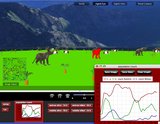Biology Unit

The StarLogoTNG Biology Curriculum is a set of activities that centers on the themes of ecology and evolution. It uses the simple interactions of carrots, rabbits, and wolves, along with various abiotic factors, to highlight the concepts inherent in decentralized systems that are traditionally difficult for students to understand. The projects require students to learn simple programming with the aim of fostering computer usage in science, but the major focus of each activity is system observation and data analysis.
The curriculum is intended as a set of supplementary activities for the normal ecology and evolution units. While it may be used as a stand-alone unit, there may be details regarding each topic that have been removed for modeling purposes. Thus, it is recommended that teachers intersperse traditional teaching days between activities to cover any missing detail, as well as to give students time to digest the material.
Download the entire biology curriulum as a zip file .
The unit below covers biology concepts in behavior, ecology, evolution and genetics.
NEW! There is a second unit that covers DNA, RNA and protein synthesis. You can get an overview of that unit or download the entire unit including StarLogo TNG files and materials.
Biology Curriculum At-A-Glance
For a more detailed overview of the curriculum, check out the
teacher overview
. Teacher guide and student activity sheets for each lesson are all in one document. (
doc
,
pdf
)
| Lesson Description | Materials |
|---|---|
| Lesson 1 begins with just carrots, focusing on the relationships between the carrots and the abiotic elements of the ecosystem. Because the rest of the lessons deal focus primarily on biotic factors, this introductory lesson serves as a reminder that the abiotic factors are just as important. | |
| Lesson 2 takes a step back from the biology theme with the VANTS (virtual ants) activity. This activity allows students to create visual designs on the StarLogoTNG SpaceLand using only very few simple commands. | |
| Lesson 3 begins the ecosystem modeling, requiring the students to program their own rabbits. During this process, students learn the essential procedures that rabbits in the model follow (hop, eat, reproduce, die) that are necessary for a simple functioning ecosystem. | |
| Lesson 4 introduces a gaming aspect that serves the dual purpose of entertaining the students while bringing up the role of humans in the ecosystem. The code now includes a small wolf population, and students program a first person hunter character that shoots the wolves. | |
| Lesson 5 introduces the ideas of competition and selection. For simplicity, the model has returned to being only carrots and rabbits. | |
| Lesson 6 brings together the driving forces behind evolution with the actual mechanism of mutation. In this project students can change the mutation rate and temperature via sliders. |
Sample Lesson
Lesson 4 introduces a gaming aspect that serves the dual purpose of entertaining the students while bringing up the role of humans in the ecosystem. The code now includes a small wolf population, and students program a first person hunter character that shoots the wolves. The model begins with a stable configuration, which students disturb by simply decreasing the age required for wolves to reproduce. The resultant overpopulation tends to overeat and wipe out the rabbits, so the hunters are used to stabilize the population. This lesson brings up ethical issues of hunting and the effects of human interactions with the ecosystem.

- Login to post comments